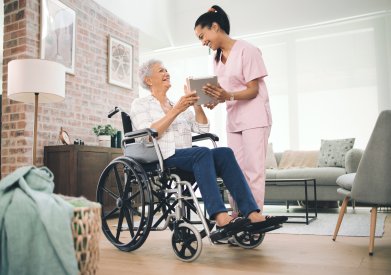A Voice They Understand: How Translation Devices Build Trust and Transform Patient Care

November 20, 2025
Mrs. Alvarez, an 83-year-old woman recovering from total hip replacement surgery, speaks very little English. When staff at the skilled nursing facility where she’s recovering try to help her stand or ask if she’s in pain, confusion grows on both sides as gestures replace clear verbal communication.
One morning, she reaches for a small hand-held translation device she was given when she arrived at the facility. She gestures to the nursing staff to speak into it.
The nurse asks: “Do you have any pain?”
The device responds in Spanish: “¿Tiene dolor?”
Mrs. Alvarez nods and replies, “Sí, aquí.”
In just a few seconds, the translation device changes everything. Mrs. Alvarez feels heard, her nurse feels confident, and trust begins to take shape.
This story is a work of fiction, but moments like it occur every day in health care settings across the country – proof that trust begins with communication.
Two years ago, University of Washington geriatricians Gina Kim, MD, MPH, and Mengru “Ruru” Wang, MD, MPH, set out to address a challenge much like the one experienced by Mrs. Alvarez and her care team: how to improve communication with patients in skilled nursing facilities who speak a language other than English.
While interpreter services are the gold standard, they’re not always easy to access – phones or tablets may not be readily available, in-person interpreters are rare, and sometimes staff ask family members to help with translation. In busy, under-resourced skilled nursing facilities, that often leaves clinicians to provide care without translation at all. (These challenges aren’t limited to skilled nursing facilities; communication barriers affect patients across the health system.)
“Interpreters are not used for small interactions, which is likely scary for patients.”
“Patients who speak a language other than English aren’t receiving the same quality of care as patients who speak English …Something needs to change.”
Drs. Kim and Wang realized that hand-held translation devices would allow staff and patients to ask simple questions quickly, a critical step in building trust and improving patient interactions.
“The staff or patient can speak or type into the HIPAA compliant device, and the device immediately translates the conversation,” Dr. Wang explained. “It’s similar to Google Translate, but uses built-in translation engines for accuracy and natural phrasing.”
Through the ABIM Foundation’s Building Trust: Advancing Health Equity grant program, Drs. Kim and Wang introduced these devices at four skilled nursing facilities in the Seattle metro area.
More than 2,500 conversations have since been translated.
Lessons Learned
- Leadership matters: Sites with strong champions and leadership buy-in saw the highest adoption of the devices. Building relationships early by taking the time to meet the staff and leadership and clearly communicate the “why” behind the devices helped staff understand that the goal was to support patients and staff.
- Accessibility is key: Keeping the devices at patients’ bedsides empowered them to encourage staff to use the devices.
- Unexpected benefits: One patient shared that the device not only improved their care experience but also helped them learn English—a great reminder that even simple tools can have benefits beyond initial expectations.
- Sustainability adds value: Participating sites were able to keep the translation devices after the grant period ended, adding long-term value and helping sustain the trust and connection built during the project.
By integrating translation devices into everyday care, Drs. Kim and Wang have empowered patients and skilled nursing facility staff to communicate with compassion, knowing that patients’ needs will be heard and understood.
Chat by chat, staff are breaking down barriers and building trust.


